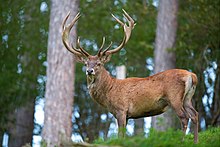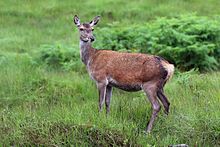
Back Edelhert AF Cervus elaphus AN أيل أحمر Arabic الايل الاحمر ARZ Cervus elaphus AST Wocol (Cervus elaphus) AVK Nəcib maral AZ مارال AZB Аҫыл болан BA Alnis BAT-SMG
| Red deer Temporal range: Early Middle Pleistocene to Recent
| |
|---|---|

| |
| Male (stag) | |

| |
| Female (hind) Glen Garry, Highland, Scotland | |
| Scientific classification | |
| Domain: | Eukaryota |
| Kingdom: | Animalia |
| Phylum: | Chordata |
| Class: | Mammalia |
| Order: | Artiodactyla |
| Family: | Cervidae |
| Subfamily: | Cervinae |
| Genus: | Cervus |
| Species: | C. elaphus
|
| Binomial name | |
| Cervus elaphus | |
| Subspecies | |
| |

| |
| Range of the red deer (Cervus elaphus), includes range of Central Asian red deer: reconstructed recent
| |
The red deer (Cervus elaphus) is one of the largest deer species. A male red deer is called a stag or hart, and a female is called a doe or hind. The red deer inhabits most of Europe, the Caucasus Mountains region, Anatolia, Iran, and parts of western Asia. It also inhabits the Atlas Mountains of Northern Africa; being the only living species of deer to inhabit Africa. Red deer have been introduced to other areas, including Australia, New Zealand, the United States, Canada, Peru, Uruguay, Chile and Argentina.[2] In many parts of the world, the meat (venison) from red deer is used as a food source.
Red deer are ruminants, characterized by a four-chambered stomach. Genetic evidence indicates that the red deer, as traditionally defined, is a species group, rather than a single species, though exactly how many species the group includes remains disputed.[3][4] The closely related and slightly larger American elk, or wapiti, native to North America and northeastern Asia, had been regarded as a subspecies of red deer, but recently it has been established as a distinct species. The ancestor of all red deer (and wapiti) probably originated in central Asia and resembled sika deer.[5]
Although at one time red deer were rare in parts of Europe, they were never close to extinction. Reintroduction and conservation efforts, such as in the United Kingdom and Portugal,[6] have resulted in an increase of red deer populations, while other areas, such as North Africa, have continued to show a population decline.
- ^ Lovari, S.; Lorenzini, R.; Masseti, M.; Pereladova, O.; Carden, R.F.; Brook, S.M. & Mattioli, S. (2019) [errata version of 2018 assessment]. "Cervus elaphus". IUCN Red List of Threatened Species. 2018: e.T55997072A142404453. doi:10.2305/IUCN.UK.2018-2.RLTS.T55997072A142404453.en. Retrieved 22 May 2020.
- ^ Red Deer – South America | Online Record Book Preview. scirecordbook.org
- ^ Moore, G.H.; Littlejohn, R.P. (1989). "Hybridisation of farmed wapiti (Cervus elaphus manitobensis) and red deer (Cervus elaphus)". New Zealand Journal of Zoology. 16 (2): 191–198. doi:10.1080/03014223.1989.10422568.
- ^ Perez-Espona, S.; Hall, R. J.; Perez-Barberia, F. J.; Glass, B. C.; Ward, J. F.; Pemberton, J. M. (2012). "The Impact of Past Introductions on an Iconic and Economically Important Species, the Red Deer of Scotland". Journal of Heredity. 104 (1): 14–22. doi:10.1093/jhered/ess085. PMID 23091222.
- ^ Geist, Valerius (1998). Deer of the World: Their Evolution, Behavior, and Ecology. Mechanicsburg, Pa: Stackpole Books. ISBN 0-8117-0496-3.
- ^ For the situation in Portugal in 2017, see Público, 2017, January 13
